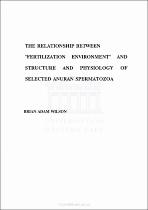| dc.contributor.advisor | Channing, Alan | |
| dc.contributor.author | Wilson, Brian Adam | |
| dc.date.accessioned | 2023-06-13T07:00:22Z | |
| dc.date.available | 2023-06-13T07:00:22Z | |
| dc.date.issued | 1993 | |
| dc.identifier.uri | http://hdl.handle.net/11394/10186 | |
| dc.description | Philosophiae Doctor - PhD | en_US |
| dc.description.abstract | The propagation of species and modes of fertilization of higher vertebrates are aspects which have been extensively researched. Studies on the spermatology of lower vertebrates have not received the same attention. Anurans exhibit modes of fertilization which place them in a category between true aquatic and true internal fertilizers. They occupy fertilization environments ranging from aquatic to internal. This project was undertaken to establish baseline values for selected anuran spermatozoa and to test the hypothesis that fertilization environment plays a role in regulating sperm form and function.
Anuran spermatozoon structure and ultrastructure were investigated and comparisons drawn between sperm from aquatic and terrestrial fertilizers. Measurements of sperm heads, acrosomes and tail complexes were used to discern whether significant differences exist between sperm from aquatic and terrestrial anuran fertilizers.
Techniques were developed to determine baseline values for spermiograms of selected anuran species. These values were also compared to test the effect of selection pressures of the fertilization environment on sperm morphology and physiology. Sperm motion as a parameter to ascertain the viability of sperm was evaluated by using a Computer Assisted Sperm Motility Analysis (CASMA) system viz. the Sperm Motility Quantifier (SMQ). The pattern and vigour of sperm motion were used as additional data to further elucidate the above mentioned hypothesis.
Spermatozoa were aspirated from Xenopus Iaevis toads by developing methods to obtain sperm from amplectant males and via an electro-ejaculation technique. The motility patterns were assessed and compared to determine similarities or differences between testicular and ejaculated spermatozoa.
The research indicated that the fertilization environment plays a major role in modulating sperm structure and function but that the effect of phylogeny is as important. The baseline values obtained during this project could possibly be utilised in programmes to protect endangered anuran species e.g. by using these values for the cryopreservation of sperm. | en_US |
| dc.language.iso | en | en_US |
| dc.publisher | University of the Western Cape | en_US |
| dc.subject | Fertilization environment | en_US |
| dc.subject | Anuran Spermatozoa | en_US |
| dc.subject | Ultrastructure | en_US |
| dc.subject | Sperm structure | en_US |
| dc.subject | Phylogeny | en_US |
| dc.title | The relationship between "fertilizaiton environment" and structure and physiology of selected Anuran Spermatozoa | en_US |
| dc.rights.holder | University of the Western Cape | en_US |

